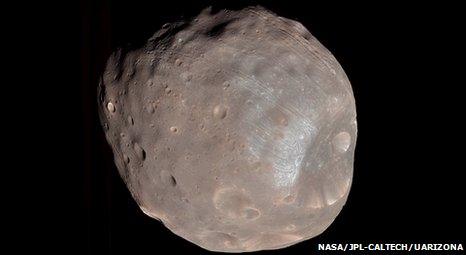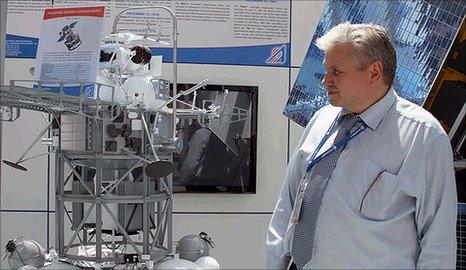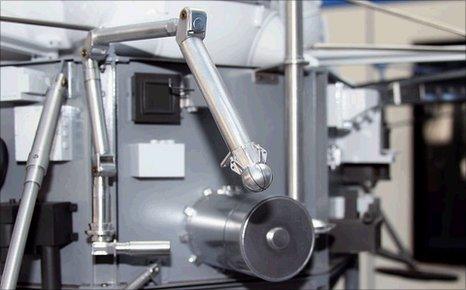Difficult rebirth for Russian space science
- Published

Phobos is the larger and closer of Mars' two moons
Earlier this month, inside Paris' majestic Grand Palace, Russia was showcasing its cultural and technological achievements.
Portraying a harmonious and progressive society, colourful musical performances and art exhibits were showing alongside impressive displays of Russia's aerospace power, oil industry and other high-tech sectors.
At the heart of the Russian space pavilion was an exhibit for the NPO Lavochkin design bureau - the nation's veteran developer of unmanned planetary probes.
Lavochkin's exhibit proudly displayed a scale-model of the Phobos-Grunt spacecraft, a mission to land on the potato-shaped moon of Mars and return grains of its mysteriously light surface back to Earth.
Involving a number of international participants, Phobos-Grunt was being advertised as Russia's flagship deep-space mission, paving the way for the country's return to planetary exploration after a two-decade hiatus.
The problem, however, is that Phobos-Grunt developed a credibility problem in the international space community. Conceived in the midst of the post-Soviet economic crisis at the end of the 1990s, it remained a paper project for years.
Then, the rebound of the Russian economy afforded the revival of the program. However, as history proved many times, money could not buy what only years of efforts could acquire, be it Olympic gold or the complex world of cutting-edge science.
While Russia's cosmonauts continued to rocket into orbit with Swiss-clock regularity, even in the worst economic times, all efforts to jump-start the nation's neglected planetary exploration programme had so far failed.
In the meantime, Nasa's planetary spacecraft ventured into the farthest expanses of the Solar System, its rovers logged many miles on the dunes of Mars. Specialised probes penetrated the atmosphere of Jupiter and landed on the surface of Titan.
Even relative newcomers to unmanned missions, such as the European space agency, China, India and Japan, flew impressive planetary missions, which post-Soviet Russia is yet to match.
Ironically, even the Russian Federal Space Agency (Roscosmos) brochures advertising the country's space programme are often adorned with images of planets beamed to Earth by American spacecraft.
With high political stakes over the revival of deep-space missions, Russian space bosses would not take "no" for an answer.
Last year, the official Russian media ran many optimistic stories about the upcoming launch of the Phobos-Grunt spacecraft - which had been promised to occur in the Autumn.
The Russian space agency vigorously denied a few independent reports, which most industry insiders had long known to be accurate, that Phobos-Grunt was not going anywhere any time soon.
Inevitable delay
Only weeks before the promised launch of the mission, Russian scientists informed their colleagues abroad that Phobos-Grunt would have to wait for the next available launch window, external to Mars at the end of 2011.
An additional two years gave Russian engineers and scientists some breathing room to sort things out and finally make it right. NPO Lavochkin's new head, Viktor Khartov, was on hand at the Grand Palace exhibit to describe a renewed effort to launch Phobos-Grunt in 2011.
The retirement of Mr Khartov's predecessor last January was widely seen as fall-out from the failure to launch the mission on time.
A veteran space engineer, Mr Khartov told BBC News that despite all previous problems, Phobos-Grunt had nowhere to go but to Phobos in 2011.
"I can't claim that we can achieve a 100% success probability, the mission is very complex and it has many high-risk aspects… but we are working in this direction," Mr Khartov said.

Viktor Khartov recently took over as the new head of the mission
With the new launch deadline looming some 17 months from now, Russian engineers have their work cut out for them. It would be the first Russian space probe to go into deep space since 1988, not counting the launch of a single Mars mission in 1996, which failed immediately after reaching Earth orbit.
A difficult undertaking by any account, the Phobos-Grunt became a major test for the Russian space science, which is still emerging from almost two decades of financial collapse and brain drain.
According to Mr Khartov, out of 4,500 employees at NPO Lavochkin, 700 people were between the age of 70 and 80. In the meantime, 700 people were considered young specialists.
"I can't let this old generation go before they pass their experience to new people," Mr Khartov says, "There is no secret, this is difficult."
The generation gap, however, was not an excuse for another delay, the NPO Lavochkin chief explained. The funding was now stable and it was enough time to take care of all challenges facing the project.
Computer brain
From the outset, the biggest hurdle before the Phobos-Grunt mission has been its brain.
The main computer of the spacecraft had to be responsible for a multitude of tasks and emergency situations beginning from launch: reaching Martian orbit and, ultimately, conducting a carefully orchestrated rendezvous with the tiny moon.
In turn, the approach to Phobos would culminate with a careful touchdown on the alien and almost weightless world.
With little gravity to pull the spacecraft in and no anchoring mechanisms, special thrusters would have to be used to "press" the spacecraft onto the surface.
The landing would be followed by a series of complex moves by the probe's mechanical arms to pick samples of the moon's regolith and to load them into the return rocket.
A smaller flight control computer would then guide the return vehicle during a lift-off from Phobos, followed by manoeuvres in the orbit of Mars and finally by a trip back to Earth.
A brand-new flight control system originally proposed for Phobos-Grunt promised new capabilities.
However, Lavochkin's internal team responsible for its development fell behind schedule, making the 2009 launch window untenable.
And the team is not out of the woods yet: "We have some concerns… however we make everything possible to help the (flight control) team in their work," Mr Khartov explains.
"I even issued a special order, requiring other divisions to share experience and provide other assistance to the Phobos-Grunt team."
According to Mr Khartov, two specialised test facilities had been now up and running at NPO Lavochkin designed to test the spacecraft's electronic brains in all phases of the mission and in every conceivable and inconceivable emergency situation.
Soil test
In the extra time available before launch, Russian scientists were also re-evaluating the most critical operation of the mission - the gathering of soil samples.
They have used the downtime to increase the mission's chances of success by fitting an all-new Polish-built drilling device, dubbed Chomik ("hamster") into the ship's scientific payload.
According to Aleksandr Zakharov, a leading project expert at Moscow's Space Research Insitute (IKI) very little is known about the soil of Phobos and the surface may well prove too rocky for the probe's delicate robotic arm to collect samples on its own.
The newly added drill resembles a jackhammer, yet weighs just 2kg (4.4lbs) and consumes only 1.5 Watts of power.
It was originally developed by the Space Research Center of the Polish Academy of Sciences in Warsaw for Esa's Rosetta mission to penetrate the icy surface of a comet.

A remote manipulator built in Russia will sample soil from the moon
On the Phobos-Grunt mission, its job will be to break down rock samples into small enough chunks for the robotic arm to load aboard the probe's Earth return capsule and also the receptacles provided for in situ analysis.
"Our main task now is to integrate the Polish drill with the original instrument package," said Mr Zakharov, "Most probably, the device won't be needed - but since we have been given an extra two years to prepare for the mission, we decided it was worth having a back-up."
According to Khartov, Chomik would be fitted onto the remote manipulator developed at Lavochkin, which would bring the device to the surface.
IKI scientists have also used the delay to rehearse how the probe will go about its soil-sampling on the surface of the Martian moon.
Due to the 20-minute time lag between signals being transmitted from Mars and arriving on Earth, they hope to rely on the probe's highly intelligent image-assessment technology - delivered via panoramic and stereo cameras - to select the most promising sites for sampling.
As always in geology, rocks will be the most attractive targets. But with a day on Phobos lasting less than eight hours, the probe will have only three-hour periods of "daylight" in which to conduct its surveys of the surrounding landscape.
Aleksandr Zakharov admits that the original launch date of September 2009 did not leave enough time to perfect the system.
Now it is being refined at a Lavochkin test facility in the Moscow suburb of Khimki that mimics the surface of Phobos. The work is expected to continue for about a year.
Assuming a launch from Baikonur in December 2011, Phobos-Grunt will arrive at Mars in August-September 2012.
It will circle the planet until December 2012 before slowly re-shaping its orbit to approach Phobos by February 2013 and touching down on the Martian moon a month later.
If everything goes as planned, a return capsule with samples of the moon's soil will reach Earth in August 2014.
Finishing line
To meet the end of the 2011 launch deadline, all the scientific instruments built for the Phobos-Grunt project, which were undergoing refurbishment, have to be returned to NPO Lavochkin during the Summer and Autumn for re-installation on the flight version of the spacecraft.
A fully assembled spacecraft is then expected to go through a series of rigorous tests in a vacuum and at extreme temperatures in the first half of next year. It is expected to be shipped to the Baikonur Cosmodrome launch site in Kazakhstan between August and September 2011.
One scientific experiment, which did remain aboard Phobos-Grunt during the two-year hiatus, was a container containing Earth bacteria.
The experiment, which was conceived by the US-based Planetary Society, a space advocacy group, aims to test the theory of "panspermia," which hypothesises that live organisms could survive interplanetary travel to "seed" life on other worlds.
Although it would not be anything like landing on Phobos, the return to Earth is another aspect of the Phobos-Grunt mission, whose details are yet to be worked out.
What is certain, is that the capsule with the samples of Phobos would have no active homing devices, such as radio beacons.
As a result, ground-based radar and optical observations would be the sole means of tracking the vehicle during its re-entry and pinpointing the site of its touchdown. Such methods make the role of ground-based tracking systems extremely important.
"Obviously, we don't want to complete this very complex mission, only to end up losing this tiny capsule during landing," Khartov said.
To improve the chances of a successful landing, mission planners quietly chose the Sary Shagan test range in Kazakhstan as their primary landing site.
US discussions
Sary Shagan is one of the birthplaces of Soviet anti-missile defense technology. It still serves as a key test base for Russian anti-missile interceptors and associated guidance radar.
To prove the landing concept of the mission, NPO Lavochkin conducted helicopter drop tests, which did confirm that the radar at Sary Shagan was able to detect and track the probe's tiny capsule. Still, many aspects of landing, including the training of search and recovery personnel remain to be sorted out.
Still, alternative options for the Phobos-Grunt landing site remained on the table. "We asked ourselves - where is the world's best anti-missile defence?" Mr Khartov said jokingly.
However several sources within the Russian space industry did confirm that fully serious (though informal) contacts between Russian and US space officials discussed the possibility of ending the Phobos-Grunt mission on US territory. However, it was clear the scenario might come with strings attached.
Even very preliminary talks led to requests to provide samples from Phobos, Russian officials said.
Although Russian scientists said they would be prepared to share the scientific knowledge delivered by Phobos-Grunt, many felt proposals to distribute the most valuable fruits of the mission in exchange for technical assistance could set an undesirable precedent.
As this would be the first Russian planetary mission in almost two decades, the nation's scientific community could be understandably sensitive about access procedures to Phobos-Grunt's scientific harvest.
As Parisians admired the scale model of Phobos-Grunt in the Grand Palace, on 13 June 2010, a bright meteor lit up the skies over Australia. These were remnants of Japan's Hayabusa spacecraft re-entering Earth's atmosphere after a long journey through space, including a visit to an asteroid.
Despite encountering enormous technical problems on its long voyage, the ship's small capsule, which was designed to return rock and soil samples from the asteroid Itokawa, made a soft landing in the Australian outback and was successfully recovered.
At the time of publication, it was still unknown whether the trouble-prone Japanese mission delivered any samples. But whatever the outcome, Hayabusa has given Russia's space programme yet another yardstick with which to measure its progress.